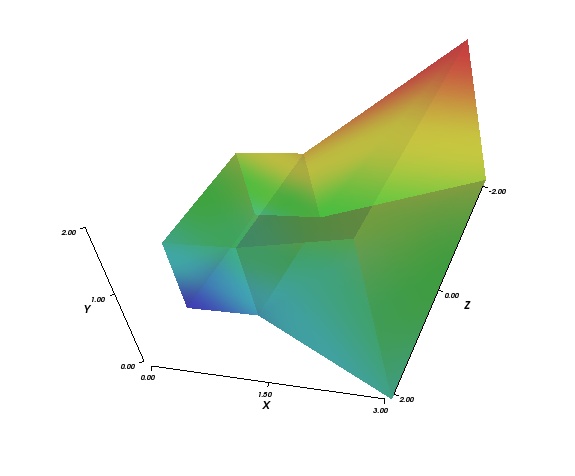Read Xdmf: Difference between revisions
From XdmfWeb
Jump to navigationJump to search
Dave.demarle (talk | contribs) mNo edit summary |
No edit summary |
||
| Line 62: | Line 62: | ||
The XML is stored in the file "MyGrid.xmf". The following Python program demonstrated parsing the XML and | The XML is stored in the file "MyGrid.xmf". The following Python program demonstrated parsing the XML and | ||
retrieving the data values. | retrieving the data values. | ||
from Xdmf import * | from Xdmf import * | ||
reader = XdmfReader.New() | |||
dom. | dom = XdmfReader.read('MyGrid.xmf') | ||
# We now have a tree. Find the one and only Grid element | # We now have a tree. Find the one and only Grid element | ||
grid = dom.getUnstruturedGrid(0) | |||
grid = | |||
top = grid.GetTopology() | top = grid.GetTopology() | ||
print 'Values = ', top.getValuesString() | |||
# Release values from data when done | |||
top.release() | |||
geo = grid.GetGeometry() | geo = grid.GetGeometry() | ||
print 'Geo Type = ', geo.getType().getName(), ' # Points = ', geo.getNumberPoints() | |||
print 'Geo Type = ', geo. | print 'Points = ', geo.getValuesString() | ||
print 'Points = ', | geo.release() | ||
# for each Attribute, print Light Data and Values | # for each Attribute, print Light Data and Values | ||
for i in range(grid. | for i in range(grid.getNumberAttributes()) : | ||
attr = grid. | attr = grid.getAttribute(i) | ||
print 'Attribute ', i, ' Name = ', attr. | print 'Attribute ', i, ' Name = ', attr.getName() | ||
# Attribute HeavyData is not Updated by default | # Attribute HeavyData is not Updated by default | ||
# there could potentially be many causing huge IO | # there could potentially be many causing huge IO | ||
attr. | attr.read() | ||
print 'Values ', attr.getValuesString() | |||
attr.release() | |||
Revision as of 12:43, 10 November 2014
Reading XDMF Data
The following Xdmf XML file is a simple example of a Uniform Grid that contains two Hexahedron that share a face. There are values centered at the nodes and at the cell centers. The values for geometry, connectivity, and scalars are all stored directly in the XML file.
<?xml version="1.0" ?>
<!DOCTYPE Xdmf SYSTEM "Xdmf.dtd" []>
<Xdmf>
<Domain>
<Grid Name="TestGrid">
<Topology Type="Hexahedron" NumberOfElements="2" >
<DataItem Format="XML" DataType="Float"
Dimensions="2 8">
0 1 7 6 3 4 10 9
1 2 8 7 4 5 11 10
</DataItem>
</Topology>
<Geometry Type="XYZ">
<DataItem Format="XML" DataType="Float" Precision="8"
Dimensions="4 3 3">
0.0 0.0 1.0
1.0 0.0 1.0
3.0 0.0 2.0
0.0 1.0 1.0
1.0 1.0 1.0
3.0 2.0 2.0
0.0 0.0 -1.0
1.0 0.0 -1.0
3.0 0.0 -2.0
0.0 1.0 -1.0
1.0 1.0 -1.0
3.0 2.0 -2.0
</DataItem>
</Geometry>
<Attribute Name="NodeValues" Center="Node">
<DataItem Format="XML" DataType="Float" Precision="8"
Dimensions="4 3" >
100 200 300
300 400 500
300 400 500
500 600 700
</DataItem>
</Attribute>
<Attribute Name="CellValues" Center="Cell">
<DataItem Format="XML" DataType="Float" Precision="8"
Dimensions="2" >
100 200
</DataItem>
</Attribute>
</Grid>
</Domain>
</Xdmf>
The XML is stored in the file "MyGrid.xmf". The following Python program demonstrated parsing the XML and retrieving the data values.
from Xdmf import *
reader = XdmfReader.New()
dom = XdmfReader.read('MyGrid.xmf')
# We now have a tree. Find the one and only Grid element
grid = dom.getUnstruturedGrid(0)
top = grid.GetTopology()
print 'Values = ', top.getValuesString()
# Release values from data when done
top.release()
geo = grid.GetGeometry()
print 'Geo Type = ', geo.getType().getName(), ' # Points = ', geo.getNumberPoints()
print 'Points = ', geo.getValuesString()
geo.release()
# for each Attribute, print Light Data and Values
for i in range(grid.getNumberAttributes()) :
attr = grid.getAttribute(i)
print 'Attribute ', i, ' Name = ', attr.getName()
# Attribute HeavyData is not Updated by default
# there could potentially be many causing huge IO
attr.read()
print 'Values ', attr.getValuesString()
attr.release()
